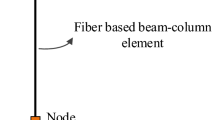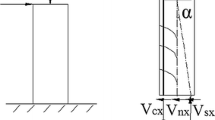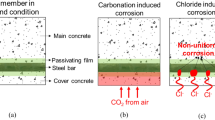Abstract
Corrosion of steel reinforcement is one of the most common durability issues for reinforced concrete (RC) structures, especially when located in marine areas. The study of the mechanical consequences of this pathology is of great importance to assess their performance. Experimental campaigns have been carried out on corroded structures. So far, assessing quasi-static behavior or predicting the dynamic response of structures have been based exclusively on quasi-static loadings. In particular, the dissipated energy and the damping capacity, which are important features to study when assessing the seismic performance of corroded RC members, are evaluated based on quasi-static loadings. The objective of this study is to characterize these two significant engineering demand parameters (EDP) using both quasi-static and dynamic tests. To reach this goal, an experimental campaign is conducted on large-scale RC beams. The corroded and non-corroded RC beams are subjected to a four-point bending loading and to dynamic loading keeping the same loadings and boundary conditions. The dynamic loading is applied on the specimen by means of the AZALEE shaking table. In this paper, a brief description of the experimental campaign is made. Then, results showing the influence of the corrosion rate on the dissipation capacity of RC structures are exposed. Especially, the consistency between quasi-static and dynamic results is assessed and discussed.













Similar content being viewed by others
References
Almusallam AA (2001) Effect of degree of corrosion on the properties of reinforcing steel bars. Construct Build Mater. https://doi.org/10.1016/S0950-0618(01)00009-5
Andrade C, Alonso C, Molina FJ (1993) Cover cracking as a function of bar corrosion: Part I-Experimental test. Mater Struct. https://doi.org/10.1007/BF02472805
Almusallam AA, Al-Gahtani AS, Aziz AR (1996) Effect of reinforcement corrosion on bond strength. Construct Build Mater 10(2):123–129
Mancini G, Tondolo F, Iuliano L, Minetola P (2014) Local reinforcing bar damage in rc members due to accelerated corrosion and loading. Construct Build Mater. https://doi.org/10.1016/j.conbuildmat.2014.07.011
Meda A, Mostosi S, Rinaldi Z, Riva P (2014) Experimental evaluation of the corrosion influence on the cyclic behaviour of RC columns. Eng Struct. https://doi.org/10.1016/j.engstruct.2014.06.043
Malumbela G, Alexander M, Moyo P (2010) Variation of steel loss and its effect on the ultimate flexural capacity of RC beams corroded and repaired under load. Construct Build Mater. https://doi.org/10.1016/j.conbuildmat.2009.11.012
Malumbela G, Moyo P, Alexander M (2009) Behaviour of RC beams corroded under sustained service loads. Construct Build Mater. https://doi.org/10.1016/j.conbuildmat.2009.06.005
Rinaldi Z, Imperatore S, Valente C (2010) Experimental evaluation of the flexural behavior of corroded P/C beams. Constru Build Mater. https://doi.org/10.1016/j.conbuildmat.2010.04.029
Zhu W, François R (2014) Corrosion of the reinforcement and its influence on the residual structural performance of a 26-year-old corroded RC beam. Construct Build Mater. https://doi.org/10.1016/j.conbuildmat.2013.11.015
Guo A, Li H, Ba X, Guan X, Li H (2015) Experimental investigation on the cyclic performance of reinforced concrete piers with chloride-induced corrosion in marine environment. Eng Struct. https://doi.org/10.1016/j.engstruct.2015.09.031
Ma Y, Che Y, Gong J (2012) Behavior of corrosion damaged circular reinforced concrete columns under cyclic loading. Construct Build Mater. https://doi.org/10.1016/j.conbuildmat.2011.11.002
Casolo S, Milani G, Uva G, Alessandri C (2013) Comparative seismic vulnerability analysis on ten masonry towers in the coastal Po Valley in Italy. Eng Struct 49:465–490
Jacobsen LS (1960) Damping in composite structures, II WCEE, Tokyo
Zou DJ, Liu TJ, Qiao GF (2014) Experimental investigation on the dynamic properties of RC structures affected by the reinforcement corrosion. Adv Struct Eng 17(6):851–860
Razak HA, Choi FC (2001) The effect of corrosion on the natural frequency and modal damping of reinforced concrete beams. Eng struct 23(9):1126–1133
Yuan W, Guo A, Yuan W, Li H (2018) Shaking table tests of coastal bridge piers with different levels of corrosion damage caused by chloride penetration. Construc Build Mater 173:160–171
Heitz T, Le Maoult A, Richard B, Giry C, Ragueneau F (2018) Dissipations in reinforced concrete components: Static and dynamic experimental identification strategy. Eng Struct. https://doi.org/10.1016/j.engstruct.2018.02.065
Mosley WH, Hulse R, Bungey JH (2012) Reinforced concrete design: to Eurocode 2. Macmillan International Higher Education, 2012
Fardis MN (2009) Seismic design, assessment and retrofitting of concrete buildings: based on EN-Eurocode 8, vol 8. Springer, Berlin
AFNOR (2005) Steel for the reinforcement of concrete – weldable reinforcing steel – General
Paradis F (2009) Influence de la fissuration du béton sur la corrosion des armatures : caractérisation des produits de corrosion formés dans le béton. Université Laval
Altoubat S, Maalej M, Shaikh FUA (2016) Laboratory Simulation of Corrosion Damage in Reinforced Concrete. Int J Concret Struct Mater. https://doi.org/10.1007/s40069-016-0138-7
Yuan Y, Ji Y, Shah SP (2007) Comparison of two accelerated corrosion techniques for concrete structures. ACI Struct J 104(3):344
Vidal T, Castel A, François R (2004) Analyzing crack width to predict corrosion in reinforced concrete. Cement Concrete Res. https://doi.org/10.1016/S0008-8846(03)00246-1
Xu J, Jiang L, Wang W, Jiang Y (2011) Influence of CaCl2 and NaCl from different sources on chloride threshold value for the corrosion of steel reinforcement in concrete. Construct Build Mater. https://doi.org/10.1016/j.conbuildmat.2010.07.023
Ahmad S (2009) Techniques for inducing accelerated corrosion of steel in concrete. Arab J Sci Eng 34(2):95
El Maaddawy TA, Soudki KA (2003) Effectiveness of impressed current technique to simulate corrosion of steel reinforcement in concrete. J Mater Civil Eng 15(1):41–47
Caré S, Raharinaivo A (2007) Influence of impressed current on the initiation of damage in reinforced mortar due to corrosion of embedded steel. Cement Concrete Res. https://doi.org/10.1016/j.cemconres.2007.08.022
Ožbolt J, Sola E, Balabanić G (2015) Accelerated corrosion of steel reinforcement in concrete: experimental tests and numerical 3D FE analysis, in CONCREEP 10, 2015, p. 108–117
Coccia S, Imperatore S, Rinaldi Z (2016) Influence of corrosion on the bond strength of steel rebars in concrete. Mater struct 49(1–2):537–551
Auyeung Y, Balaguru P, Chung L (2000) Bond behavior of corroded reinforcement bars. Mater J 97(2):214–220
Projet APPLET : Durée de vie des ouvrages en béton : Approches prédictives performantielles et probabilistes, (2006)
Ouglova A (2004) Etude du comportement mécanique des structures en béton armé atteintes par la corrosion, PhD Thesis, Cachan, Ecole normale supérieure
Priestley MJN (1997) Displacement-based seismic assessment of reinforced concrete buildings. J Earthquake Eng 1(01):157–192
Smyrou E, Priestley MN, Carr AJ (2011) Modelling of elastic damping in nonlinear time-history analyses of cantilever RC walls. Bulletin Earthquake Eng 9(5):1559–1578
Richard B, Martinelli P, Voldoire F, Chaudat T, Abouri S, Bonfils N (2016) SMART 2008: Overview, synthesis and lessons learned from the International Benchmark. Eng Struct 106:166–178
Li Z, Fu J, Liang Q, Mao H, He Y (2019) Modal identification of civil structures via covariance-driven stochastic subspace method. Math Biosci Eng 16(5):5709–5728
Pappa RS, Juang JN (1988) Some experiences with the eigensystem realization algorithm
Van Overschee P, De Moor BL (2012) Subspace identification for linear systems: Theory—Implementation—Applications. Springer, Berlin
Liu K (1996) Modal parameter estimation using the state space method. J Sound Vib 197(4):387–402
Cao MS, Sha GG, Gao YF, Ostachowicz W (2017) Structural damage identification using damping: a compendium of uses and features. Smart Mater Struct 26(4):043001
Farrar CR, Jauregui DA (1998) Comparative study of damage identification algorithms applied to a bridge: I Experiment. Smart Mater Struct 7(5):704
Castel A, François R, Arliguie G (2000) Mechanical behaviour of corroded reinforced concrete beams—Part 2: Bond and notch effects. Mater Struct. https://doi.org/10.1007/BF02480534
Park R (1989) Evaluation of ductility of structures and structural assemblages from laboratory testing. Bull N Z Soc Earthq Eng 22(3):155–166
Li Q, Niu D, Xiao Q, Guan X, Chen S (2018) Experimental study on seismic behaviors of concrete columns confined by corroded stirrups and lateral strength prediction. Construct Build Mater 162:704–713
Panteliou SD, Chondros TG, Argyrakis VC, Dimarogonas AD (2001) Damping factor as an indicator of crack severity. J Sound Vibrat 241(2):235–245
Kumar SS, Krishna AM, Dey A (2015) Cyclic response of sand using stress controlled cyclic triaxial tests
Heitz T, Giry C, Richard B, Ragueneau F (2019) Identification of an equivalent viscous damping function depending on engineering demand parameters. Eng Struct 188:637–649
Crambuer R (2013) Contribution à l’identification de l’amortissement: approches expérimentales et numériques
Newmark NM (1959) A method of computation for structural dynamics. J Eng Mech Div 85(3):67–94
Lejouad C, Capdevielle S, Richard B, Ragueneau F (2019) A numerical model to predict the effect of corrosion on the dynamic behavior of reinforced concrete beams
Acknowledgements
The French Institute for Radioprotection and Nuclear Safety (IRSN) and the Nuclear Energy Division of the French Sustainable Energies and Atomic Energy Commission (CEA/DEN) are kindly thanked for financial supports.
Author information
Authors and Affiliations
Corresponding author
Additional information
Publisher's Note
Springer Nature remains neutral with regard to jurisdictional claims in published maps and institutional affiliations.
Rights and permissions
About this article
Cite this article
Lejouad, C., Richard, B., Mongabure, P. et al. Experimental study of corroded RC beams: dissipation and equivalent viscous damping ratio identification. Mater Struct 55, 73 (2022). https://doi.org/10.1617/s11527-022-01906-y
Received:
Accepted:
Published:
DOI: https://doi.org/10.1617/s11527-022-01906-y




